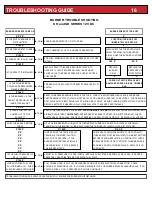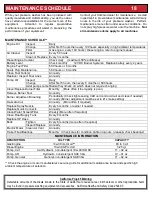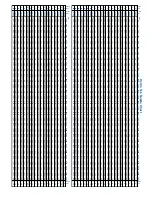
These pictures show different reasons for coil pipe
failure:
TEMPERATURE SWITCH: The burner is equipped
with a high temperature limit switch, which will shut off
the burner when the water temperature becomes too
hot. Hot water machines are equipped with an
adjustable thermostat so that the operator can control
the outlet water temperature. The burner will
automatically cycle on and off to maintain the desired
temperature.
STEAM INSTRUCTIONS: If your unit is steam
capable, install the green steam nozzle, turn
thermostat to 250° F.
PRESSURE/FLOW SWITCH: The heater/burner is
equipped with either a pressure switch or a flow
switch. When the trigger on the spray gun is
squeezed, water begins to move through the coil and
is pressurized. The flow/pressure switch turns the
heater/burner on and begins to heat the water.
Whenever the water spray stops or if the water is shut
off, the burner will shut off.
WARNING: Burner
should fire only when the trigger is squeezed and
spraying water, if it comes on at any other time,
shut off machine and have it serviced.
DIAGNOSTIC LIGHT: The burner diagnostic light on
the rocker switch (if equipped) can help in determining
problems with the burner. The red light indicates that
power is going to the fuel solenoid valve. The burner
should be firing and heating the water whenever the
red light is on. When the trigger on the spray gun is
released or if the temperature set point is exceeded,
the red light will go off and the burner will stop firing.
DIESEL FIRED BURNER: The diesel-fired burner is a
forced draft pressure-atomizing burner. Diesel fuel is
sprayed out of an atomizing nozzle, mixed with air,
and ignited by a high voltage spark. The flame is
directed towards the coils of pipe, which in turn, heats
the water flowing through it. Use clean
#2 DIESEL FUEL for the burner or
substitute #1 diesel, light fuel oil, or
Kerosene if diesel is not available.
AIR BAND adjustments may need to
be made to compensate for higher
elevations, or if more than a trace of
smoke is observed in the burner exhaust. The
ELECTRODES may need to be cleaned and adjusted
periodically. These adjustments have to be made
precisely and should be performed only by qualified
personnel. Set between #1 & #2 on the smoke gauge.
The FUEL PUMP, on diesel heated
units, is a self-priming, low volume
pump which is propelled by the burner
motor. The fuel pump pressure is
typically set at 125psi but can be
turned as high as 160psi during the
winter when the incoming water temperature is lower.
Before adjusting the fuel pressure, connect a fuel
pressure gauge and an outlet water temperature
gauge, turn the pump and burner on, and turn the fuel
pressure screw clockwise until the desired water
temperature is obtained. Air band adjustment may be
needed to maintain a clean burn. Be sure not to
exceed the recommended specifications of the
machine.
The FUEL FILTER will need to be replaced often if the
diesel fuel quality is poor. A fuel filter with a water
separator is recommended if the fuel quality is
consistently poor.
The FUEL SOLENOID is an electric fuel valve that
shuts off the fuel whenever the trigger on the spray
gun is released or if the set temperature on the heat
switch is exceeded.
Warning! When performing any tests on ignition
systems, do not touch the ignition rod. Ignition
circuit generates over 10,000 volts, electrical
shock can result!
The IGNITION TRANSFORMER provides a high
voltage spark that travels down the electrodes to ignite
the diesel fuel. Disconnect all power before servicing.
The 12V burner operates from the battery on the SH
and SK Series. The engine has a 10 to 25 amp
charging system that keeps the battery charged which
runs the burner. The transformer stops when the
trigger gun is released and is controlled through a high
amperage contactor. To help keep the battery fully
charged, and for safely cooling down the burner, turn
off the burner during the last minute of rinsing. When
leaving the machine unattended, shut off burner and
engine switch. Replace 12 VDC battery regularly (2
year maximum interval) on 12V burner systems to
help ensure consistent performance.
Failed weld or failed material
covered under warranty
Failed pipe seam
covered under warranty
Blow out from pipe
weakened by freezing
Pipe rupture due to
freezing or obstruction
SYSTEM INFORMATION
9






































